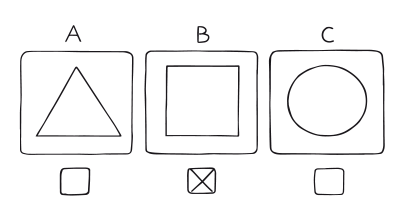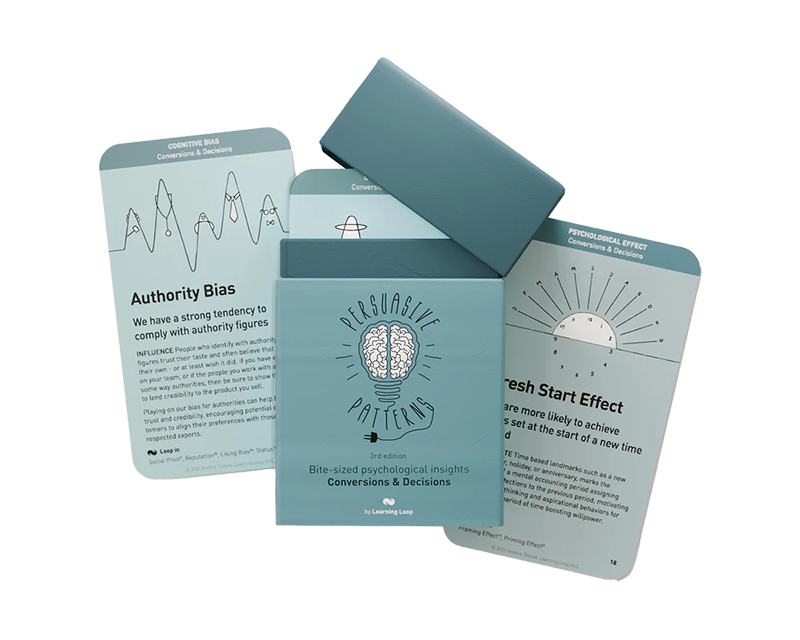Persuasive Patterns: Influence
Priming Effect
Decisions are unconsciously shaped by what we have recently experienced

The Priming Effect is the phenomenon by which exposure to one stimulus influences the response to a subsequent stimulus, without conscious guidance or intention.
You just entered a grocery store with a shopping list in hand. You’re determined to stick to it, but as you pass through the aisles, you notice that the store is playing oldies music from the 1950s. Without realizing it, you start to feel nostalgic. By the time you reach the checkout, your cart is filled with several items that weren’t on your list—classic brands and comfort foods that remind you of your childhood. This is priming at work; the music influenced your purchasing decisions, tapping into your emotions and memories associated with that era.
Now, consider an online bookstore that, upon noticing you’ve been browsing biographies of famous scientists, starts to subtly recommend books related to science, innovation, and discovery. As you continue to browse, these themes become more prominent, and you find yourself drawn to titles that resonate with the idea of exploration and human progress. The website has primed your decision-making, steering you towards a selection of books that align with the theme you’ve shown interest in, even if you weren’t explicitly searching for them.
The study
One of the earliest and most influential studies demonstrating the Priming Effect involved participants completing word puzzles.
In one notable experiment, participants were primed with words that were designed to activate the stereotype of the elderly without them being aware. They were exposed to words such as “Florida,” “forgetful,” “bald,” “gray,” or “wrinkle” in a scrambled sentence task. The key measure was the time it took for participants to walk from the experimental room to the elevator after the experiment concluded. The results were striking: participants who were subliminally primed with the elderly-related words walked significantly slower when leaving the experimental setup compared to those who were not exposed to the elderly stereotype. Specifically, the primed group took an average of 8.28 seconds longer to walk the distance than the control group. This finding was significant at the p<.05 level, indicating a low probability that the observed effect was due to chance.
This study captivated the psychology field by illustrating how subtle cues in our environment can unconsciously shape our actions.
Bargh, J. A., Chen, M., & Burrows, L. (1996). Automaticity of social behavior: Direct effects of trait construct and stereotype activation on action. Journal of Personality and Social Psychology, 71(2), 230-244.
The Priming Effect refers to the psychological occurrence where a prior stimulus covertly influences the response to a later stimulus. This pattern is key in molding decisions and behaviors by activating specific mental pathways without the individual’s conscious awareness. Priming works best when it respects or solidifies the user’s existing expectations and enhances their experience without misleading them.
The psychological principle of the priming effect is grounded in the understanding that exposure to a stimulus can subconsciously influence the response to another stimulus. This effect operates through the associative networks that constitute our memory system.
When one concept is activated, either by direct exposure or by sensory input, related concepts are also brought to a state of semi-activation – this is associative activation. This activation increases the ease with which these related concepts can be accessed or come to mind. For example, if a person is exposed to the word “doctor,” the concept of “nurse” or “hospital” may be more readily accessible because of the established association in memory.
The priming effect functions without the need for conscious awareness, which is why primed concepts can influence subsequent thoughts or actions without an individual realizing the source of their influenced behavior.
This principle has a solid grounding in cognitive psychology, where it is used to explain how certain types of memory tasks, like word recognition, are performed more swiftly and with greater accuracy when primed with related stimuli.
In design, the priming effect can be applied to guide user behavior and decision-making processes. For example, using specific color schemes and imagery on a website can prime a user to feel more relaxed or alert, potentially influencing their interaction with the site.
The relevance and potency of priming in design and decision-making rely on the subtlety with which it can be woven into various touchpoints to create a coherent and influential experience without overt direction or instruction. This power must be balanced with responsibility to ensure that it does not exploit or manipulate, but rather aids in making experiences more intuitive and decisions more informed.
Research insights on priming and decision-making
The impact of priming on decision-making is well-established. The research by Kusev et al. (2012) demonstrates that both the specific content of a prime and an individual’s existing beliefs can independently steer decisions. This suggests a dual influence where priming not only triggers associated concepts but also interacts with the person’s belief system to affect outcomes.
This dual influence is evident in the domain of financial decision-making, where Gilad and Kliger (2008) found that priming can affect risk attitudes. Apps and digital interfaces might use this knowledge to prime users subtly toward safer investment choices through cues associated with stability and security.
In branding, Baxter et al. (2017) highlighted how phonetic elements can prime consumer expectations. Product names with phonetic structures that evoke certain attributes can prime consumers to associate these attributes with the product, influencing their perceptions.
Syntactic priming, as discussed by Thothathiri and Snedeker (2008), reveals how familiar structures in language can prime users for better comprehension. This principle can be applied in UX copywriting, suggesting that content should be structured in a way that activates relevant associations to aid user understanding.
Blackler, Popovic, and Mahar (2003) emphasized the significance of priming in intuitive use. By activating a user’s pre-existing knowledge through design, products can be made more intuitively usable, improving the user experience.
Designing products with the Priming Effect
For primes to be effective design levers, they should align with the user’s goals and values, be noticeable without being distracting, and be simple to process. Consideration for the user’s experience means ensuring the prime enables rather than hinders the user’s task.
The very first interactions with a product or service are crucial. If a user encounters a value proposition centered around cost-efficiency at the first touchpoint, this primes them to focus on pricing throughout their experience. Conversely, if the initial message emphasizes premium quality or exclusive features, the user is more likely to be influenced by the perceived value of the product and may be less sensitive to price, focusing instead on the benefits or status associated with the purchase.
For instance, consider a software-as-a-service (SaaS) company. If the landing page a user first visits highlights testimonials praising the software’s time-saving capabilities, the user is primed to value efficiency. As they proceed to the bottom of the funnel, making the decision to purchase, those primed with time-saving benefits are more likely to invest in higher-tier plans.
- Sequence content strategically
The order in which information is presented can prime users for subsequent content. Start with positive, easy-to-process information to create a favorable initial impression, setting the stage for more complex or detailed content later. Consider how each step of the user journey can be primed for the next. For example, in an e-commerce setting, priming users with security badges and trust signals on the product page can make them more comfortable with proceeding to checkout. - Create relevant associations
Use metaphors, analogies, and stories that are relevant to your audience to create strong associations. This can help in making complex concepts more understandable and relatable.
Ethical recommendations
The application of priming extends to influencing perceptions and behaviors, necessitating a responsible approach to design. Designers must be cautious not to exploit primes as a form of manipulation or deceit. The intent should always be to facilitate and enhance the user experience, not to direct it covertly.
One significant concern is the manipulation of choices. By subtly influencing users’ subconscious, priming can lead them toward decisions that may not align with their genuine interests or needs. This manipulation can be particularly potent in environments where impulsive or emotionally driven decisions are likely, such as online shopping or social media platforms.
Another ethical challenge lies in overriding user autonomy. The essence of priming is to nudge users in a particular direction, but there’s a fine line between a nudge and a push. Over-reliance on priming can create an environment where users feel their choices are not entirely their own, undermining their sense of control and independence. This can be particularly concerning in areas like financial decisions or health-related choices, where autonomy and informed consent are crucial.
The goal should always be to enhance decision-making processes, not to control them.
- The user comes first
If priming is used, ensure it is done to aid user decision-making without misleading them in a way that genuinely benefits the user. For example, priming for educational purposes or to promote healthy habits can be beneficial. - Balance designs
Balance the use of priming with opportunities for users to make unguided, independent decisions. Offer clear, unbiased information alongside primed content.
Real life Priming Effect examples
Airbnb
At the start of the booking process, Airbnb often highlights unique experiences or popular destinations. This initial exposure to distinctive stay options primes users to consider more adventurous or unique accommodations as they progress through their booking journey, influencing their final choice of stay.
Duolingo
When users start a lesson on Duolingo, they’re often exposed to encouraging messages about language learning benefits. This priming can influence their persistence and engagement levels throughout the lesson, impacting their decision to continue with more lessons at the end.
Uber
At the start of the Uber app experience, users might see promotions for certain types of rides or messages about safety features. This priming could influence their decisions about which service to choose (UberX, Uber Pool, etc.) or increase their trust and likelihood to use the service more frequently.
Trigger Questions
- What emotions or behaviors are we aiming to prime?
- Will potential customers benefit from being primed to a specific value proposition or message when they are going to make a decision far from now?
- How do the chosen stimuli subtly align with our core product values?
- Are we priming consistently across all user touchpoints?
- What existing user beliefs or experiences can we leverage for effective priming?
- How can we measure the impact of our priming efforts?
Pairings
Priming Effect + Conceptual Metaphor
By priming users with familiar concepts, they can more easily grasp new ideas that are presented metaphorically. Identify common or universally understood concepts that relate to your product or message. Use these as priming elements before introducing more complex ideas through metaphors.

Decisions are unconsciously shaped by what we have recently experienced

We understand a new idea or concept by linking it to another
Priming Effect + Framing Effect
Priming can be used to focus a user’s attention on the benefits rather than just the features of a product or service. By priming users with messages that emphasize outcomes and experiences, the subsequent framing of product information can be more persuasive. Use visual or textual content to prime users with the end benefits of a product. Follow this with product descriptions that frame features in terms of these benefits.

Decisions are unconsciously shaped by what we have recently experienced

The way a fact is presented greatly alters our judgment and decisions
Priming Effect + Authority Bias
Priming users with elements that evoke trust and security, such as endorsements from authoritative figures, can reduce hesitation and cart abandonment in e-commerce settings. Display trust signals like security badges, expert reviews, or endorsements early in the shopping experience. This primes users to feel more secure when they reach the checkout process.

Decisions are unconsciously shaped by what we have recently experienced

We have a strong tendency to comply with authority figures
Priming Effect + Positive Mimicry
By priming users with aspirational actions and results from other users, products can leverage positive mimicry to be more intuitively usable. By combining users’ pre-existing knowledge and comfort with a product with what is possible, users can be primed with what behaviors that lead to positive change and in turn be more comfortable with engaging in them. This familiarity, established through priming, makes new interfaces more intuitive.

Decisions are unconsciously shaped by what we have recently experienced

We learn by comparing our behavior with the actions of others
Priming Effect + Recognition over Recall
Priming can enhance memory performance by making relevant information more recognizable rather than relying on recall. This can improve user experience by making interactions more seamless and less cognitively demanding. Provide users with visual cues or reminders that prime their memory for upcoming tasks or decisions. This reduces the cognitive load of having to recall information independently.

Decisions are unconsciously shaped by what we have recently experienced

We are better at recognizing things than we are recalling them from memory
A brainstorming tool packed with tactics from psychology that will help you increase conversions and drive decisions. presented in a manner easily referenced and used as a brainstorming tool.
Get your deck!- Cognition: Exploring the Science of the Mind by Reisberg
- Semantic priming well established by Meyer
- Bargh, J. A., Chen, M., & Burrows, L. (1996). Automaticity of social behavior: Direct effects of trait construct and stereotype activation on action. Journal of Personality and Social Psychology, 71(2), 230-244.
- Chartrand, T. L., & Bargh, J. A. (1999). The chameleon effect: The perception-behavior link and social interaction. Journal of Personality and Social Psychology, 76(6), 893-910.
- Dijksterhuis, A., & van Knippenberg, A. (1998). The relation between perception and behavior, or how to win a game of Trivial Pursuit. Journal of Personality and Social Psychology, 74(4), 865-877.
- Cialdini, R. B. (2001). Influence: Science and practice (4th ed.). Boston: Allyn and Bacon.
- Lyubomirsky, S., King, L., & Diener, E. (2005). The benefits of frequent positive affect: Does happiness lead to success? Psychological Bulletin, 131(6), 803-855.
- Neely, J. H. (1977). Semantic priming and retrieval from lexical memory: Roles of inhibitionless spreading activation and limited-capacity attention. Journal of Experimental Psychology: General, 106(3), 226-254.
- Isen, A. M., Daubman, K. A., & Nowicki, G. P. (1987). Positive affect facilitates creative problem solving. Journal of Personality and Social Psychology, 52(6), 1122-1131.
- Wheeler, S. C., & Petty, R. E. (2001). The effects of stereotype activation on behavior: A review of possible mechanisms. Psychological Bulletin, 127(6), 797-826.
- Tversky, A., & Kahneman, D. (1974). Judgment under Uncertainty: Heuristics and Biases. Science, 185(4157), 1124-1131.
- Kusev, P., van Schaik, P., & Aldrovandi, S. (2012). Preferences Induced by Accessibility: Evidence from Priming. Journal of Neuroscience, Psychology, and Economics, 5(4), 250-258.
- Gilad, D., & Kliger, D. (2008). Priming the Risk Attitudes of Professionals in Financial Decision Making. Review of Finance, 12(3), 567-586.
- Baxter, S. M., Ilicic, J., & Kulczynski, A. (2017). You see Froot, you think fruit: examining the effectiveness of pseudohomophone priming.
- Thothathiri, M., & Snedeker, J. (2008). Give and take: Syntactic priming during spoken language comprehension.
- Dennis, A., Yuan, L., Feng, X., Webb, E. M., & Hsieh, C. J. (2020). Digital Nudging: Numeric and Semantic Priming in E-Commerce.
- Su, L., & Gao, L. (2014). Strategy compatibility: The time versus money effect on product evaluation strategies.
- Blackler, A., Popovic, V., & Mahar, D. (2003). The Nature of Intuitive Use of Products: An Experimental Approach.

